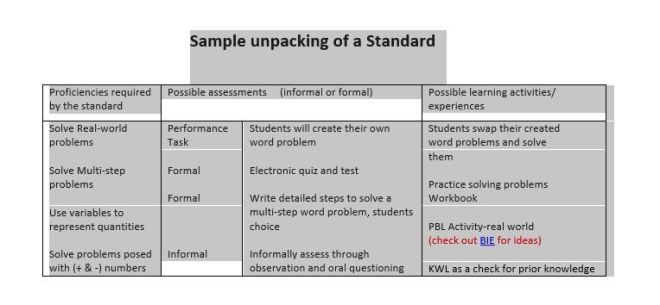Learning Outcomes and Backwards Mapping-McNeese
Some strategies teachers can use to make lessons more pointed and relevant to the goals of the standards is a technique called “Backwards Mapping” (McTighe, 2012). With this method teachers plan lessons with the end in mind. Teachers will create lessons and lesson activities that guide students to specific performance tasks and skills. Although we are hearing a lot about “backwards planning” now this is not a new strategy. According the Edutopia article “Common Core Big Idea 4: Map Backward from Intended Results” this strategy was introduced more than 65 years ago by Ralph Tyler (McTighe, 2012).
Another strategy is to plan lessons using the “Understanding by Design” method (McTighe, 2012). This method breaks the standards down into stages. The first stage outlines the desired results (goals and big ideas) of the standard. Stage two outlines what assessment tools will be used as evidence that the student goals have been met. Assessments can be both formal (tests, performance tasks, homework, etc.) and informal (observation, informal questioning, etc.). And stage three outlines the “Learning Plan” which describes what will be student learning experiences, how will the students be engaged or what activities will best help students acquire the skills or processes required by the standard.
For example, the Common Core Standard below
Solve multi-step real-life and mathematical problems posed with positive and negative rational numbers in any form (whole numbers, fractions, and decimals), using tools strategically. Apply properties of operations to calculate with numbers in any form; convert between forms as appropriate; and assess the reasonableness of answers using mental computation and estimation strategies.
can be dissected and broken into proficiencies that students should achieve to meet this standard. The proficiencies will answer the “Student From there a teacher could then plan assessments that will help the teacher, and others for that matter, know that the students have met the standards. And finally the learning experiences or activities that help the teacher know the student has develop the knowledge and skills to meet the standard.

References
McTighe, J. (2012, December 6). Common Core Big Idea r: Map Backward from Intended Results. Teacher Leadership. Edutopia.
Wiggins, G., Wilbur, D., & McTighe, J. (2002). Understanding by Design: Overview of UBD & the Design Template. Alexandria, VA: ASCD.
Image- http://www.kickasscreatives.com/why-not-try-planning-your-project-backwards-seriously-give-it-a-go/
